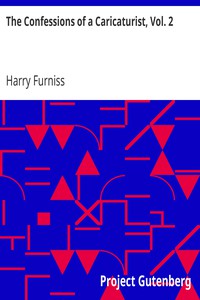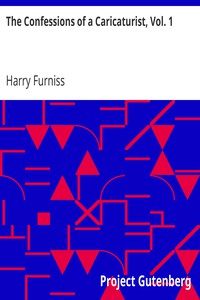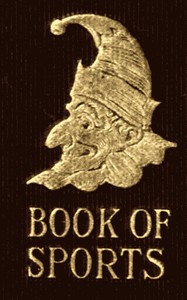The Confessions of a Caricaturist, Vol. 2 by Harry Furniss (novels for teenagers .TXT) 📖

- Author: Harry Furniss
Book online «The Confessions of a Caricaturist, Vol. 2 by Harry Furniss (novels for teenagers .TXT) 📖». Author Harry Furniss
I was somewhat startled to learn that my captive had not escaped from the Gardens, which did not contain one of its species, and Mr. Bartlett gave it as his opinion that there must have been a number more wherever this one came from. This new danger further enhanced the charms of Regent's Park, which on Saturdays is a perfect pandemonium, the pedestrian having to exert a great deal of agility to dodge the whizzing cricket balls and avoid being maimed for life. Now that we have had snakes in the grass we may expect vultures in the air, and who knows that in time to come we may not be shooting big game in the jungles of the north-west!
The above is the substance of a letter I wrote to the Times, the publication of which caused no little consternation in some papers and no little chaff, at my expense, in others. The London evening papers appeared with startling contents bills and sensational headings:
The Westminster Gazette, "In the hope of gleaning some valuable information about this newly-discovered fearful reptile which lies in wait for wayfarers in the wilds of Northern London," sent a representative post-haste to interview Mr.[Pg 220] Bartlett, the superintendent of the Zoological Gardens. This report in the Westminster is headed:
"He thought he saw an elephant
Upon the mantelpiece;
He looked again, and found it was
His sister's husband's niece,"
and then proceeds to throw doubt upon my veracity.
 THE LATE MR. BARTLETT.
THE LATE MR. BARTLETT.
"Mr. Harry Furniss has been suffering from a delusion very similar to that of the subject of Mr. Lewis Carroll's nonsense-verse. Mr. Bartlett is a man of few words, though what he does say is both interesting and humorous. Without replying"—(the Westminster representative required him to tell him all he knew about my snake)—"he took up his pen and, on the back of a visiting-card which lay before him, he drew a circle as large as the card would hold, the ends of which did not quite meet. 'There,' he said, 'that is about the actual size of Mr. Harry Furniss's snake. You see its size is not alarming, and its nature is not venomous. In fact, it is absolutely harmless.'
"'But it is of rare variety, is it not?'
"'The variety is not common, certainly, though I have known it for the last eighteen or twenty years. It is known as the small crowned snake (Coronella lævis), and is occasionally found in Hampshire and in one or two other counties. The first specimen I had was brought to me from Hampshire by a friend of mine, a young officer. As he pulled it out of his hand-bag in this room I saw it biting at his fingers. I thought it was a viper; but, of course, on examining it I soon saw what it really was. It has no fangs, and it is, as I said, quite harmless. At its full size it may measure from fourteen to sixteen inches. As for its rarity, here is a fairly long list of the specimens we have had, and we have several at present. But come along to the reptile house and see it for yourself.'
"Arrived, at the reptile house, Mr. Bartlett called the keeper, and in solemn tones and with a grave countenance requested him to 'show this gentleman Mr. Harry Furniss's serpent.' The man looked puzzled for a moment, and then gradually a broad grin spread over his face as he[Pg 221] replied: 'Oh, yes, sir, if I can find it, but I am not sure about that,' However, he removed the lid from a glass case containing several lively little creatures just about as large as a fresh-water eel at the age at which it is known to the small boy who tries to catch it in his hands as the 'darning needle.' After groping about in the sand at the bottom of the case he found the specimen required and handed it over to Mr. Bartlett, who held it in his hand and allowed it to make savage darts at his fingers. 'You see,' he said, it is a lively little thing—extremely spiteful, but quite powerless to hurt me.' After it had been put back and carefully secured, lest it should make another descent upon London, Mr. Bartlett gave his theories as to how it might have got into Regent's Park. 'There are two ways in which it might have come here,' he explained. 'I imagine it has been brought in some of the plants or shrubs which have been provided for the Park gardeners; or else somebody may have brought a female with young ones from the country and carelessly allowed this one to escape. But stray animals like this are almost sure to come to us sooner or later. Whenever people find anything unusual, they think it must be an escaped specimen and forward it here. Why, when the great explosion on the canal occurred in 1874, the glass in our aviaries was shattered. Of course a great number of our birds escaped, but it was in November, and most of them were glad enough to return to the warmth and to the food provided for them. But people were continually sending us birds for a long time, and, in fact, more birds were sent here than had actually escaped.'
"'Then, as a last question, Mr. Bartlett, what does the fuss which has been made about this snake mean?'
"Mr. Bartlett looked more solemn than ever as he suggested: 'Well, Mr. Harry Furniss is fond of a joke—Lika-Joko is a capital name for him; he may have been serious, or he may not."
I was serious, and so was dear old Mr. Bartlett, whom it was my privilege to know well, but he did not let the representative of the Westminster see this.
I replied to the above article:
"On reading your descriptive interview with Mr. Bartlett à propos of my finding a reptile in Regent's Park, I was, believe me, far more surprised than when I captured the primary cause of your representative's journey to the Zoological Gardens. You endeavour to sum up the incident and my veracity by quoting the following lines of Mr. Lewis Carroll's:—
"'He thought he saw an Elephant
Upon the mantelpiece;
He looked again, and found it was
His sister's husband's niece,'
[Pg 222]
"Now it seems to me that another extract from the same work would have lent itself better to your requirements:
"'He thought he saw a Rattlesnake
That questioned him in Greek;
He looked again, and found it was
The Middle of Next Week.
"The one thing I regret," he said,
"Is that I cannot speak!"'"
I very much regret that it—the snake—cannot speak, for were it gifted with articulate power your representative could hold a viva voce interview with his snakeship, and therefore become enlightened as to the real facts of the case. The reptile might also disclose the locality he hails from, as that important point is still shrouded in mystery.
"As soon as I had read your article, which deals somewhat frivolously with a very serious subject, I went forth to the Zoo in quest of Mr. Bartlett, but that gentleman had left town. Perhaps the article in question had something to do with his departure. Why I sought to see him was to put to him the following questions to test the accuracy of your statements:
"1. How comes it that you informed me on Saturday that the snake was a foreigner, while according to the Westminster Gazette it is English?
"2. Did you not give it to me as your opinion that it must have come in fruit? You are now made to say that it must have been brought in plants or shrubs, and if that is so, why did the Park gardeners declare that they had never seen anything like it before?
"3. Did you not say it was only a week old, and also that where it came from there must be a number more?
"4. Did you not emphatically declare that you had no specimen of the kind in the Gardens, and was it not for this reason I made you a present of this one? How do you reconcile that with the following passage in your interview with the representative of the Westminster Gazette: 'As for its rarity, here is a fairly long list of the specimens we have had, and we have several at present'? And did you not give as a reason the reptile could not have strayed from the Gardens the very cogent one that you had none of the kind in your collection? And may I ask whether you really have any or not? For if you have, and the one in question has escaped, what is to prevent rattlesnakes and cobras and other venomous specimens from escaping also?
"5. If, as you say, you doubted my seriousness, why was the snake duly entered in the books of the Zoological Society, from whom I received a formal letter of thanks for the presentation?
"6. Would you not rather handle a snake, however dangerous, than the special interviewer of a London evening paper?"
[Pg 223]
This I followed with another letter, which explains the conflicting information received at the Zoo:
 SKETCH BY MR. F. C. GOULD.
SKETCH BY MR. F. C. GOULD.
"Since writing to you it has struck me that probably your representative saw Mr. Bartlett senior, whereas I deposited my snake into the care of, and received my information from, Mr. Bartlett junior (the present superintendent). This may account for your representative describing in his article Mr. Bartlett drawing a circle the size of my snake on a visiting-card, and that, too, without the two ends of the circle coming into conjunction. This is so utterly absurd that it is evident Mr. Bartlett could not have seen the reptile at the time. The exact measurement of my baby serpent is seven and a-half inches in length—nearly an inch longer than the word 'Westminster' at the top of your front page—and it is still growing!"
So did the story grow—in correspondence, in prose, in verse, and in picture. Mr. F. C. Gould treated the subject in[Pg 224] Japanese-Lika-Joka spirit, and from quantities of verse I select the following from the Sketch as the best:
"Picked up near the Zoological Gardens."'I am the snake of Regent's Park;
I lie in wait for men of mark.
I'd gladly give my latest breath
To fright a funny man to death.
So when from ambush I espy
A comic artist passing by,
I think there is no joy like this—
To stand upon my tail and hiss.
For it is quite a novel charm
To see him start in wild alarm
And haste to tell the awful crimes
Of Horrid Serpents in the Times.
It used to be a bitter pang
That I was born without a fang,
That Nature made me as a toy
For any silly idle boy.
But now the humble snake may pass
For lurking cobra in the grass,
While people think that Regent's Park
Is Kipling Jungle after dark!'"
Several letters appeared. One from a "Harrow School Boy," in the Times, was generally accepted at the time as a solution of the mystery:
"Sir,—I keep snakes as pets, and allow them a wriggle on the grass every day. Early last week I missed one, a little black chap about 10 to 11 in. long, and have not seen him since. Perhaps the one Mr. Harry Furniss found on Saturday is my lost pet, carried away, not by one of the expected vultures, but by a roving Regent's Park rook."
This soothed some nervous readers' fears; but not all. Another correspondent wrote:
"The tale of the Regent's Park serpent (Likajokophis harryfurnissii), discovered, patented, and greatly improved upon by the vivacious caricaturist, appears to be even now not told to its bitter sequel; for I am credibly informed at the Zoological Gardens that an official of a large hospital in the neighbourhood was sent there yesterday to enquire how soon it would be safe for the convalescent patients to





Comments (0)